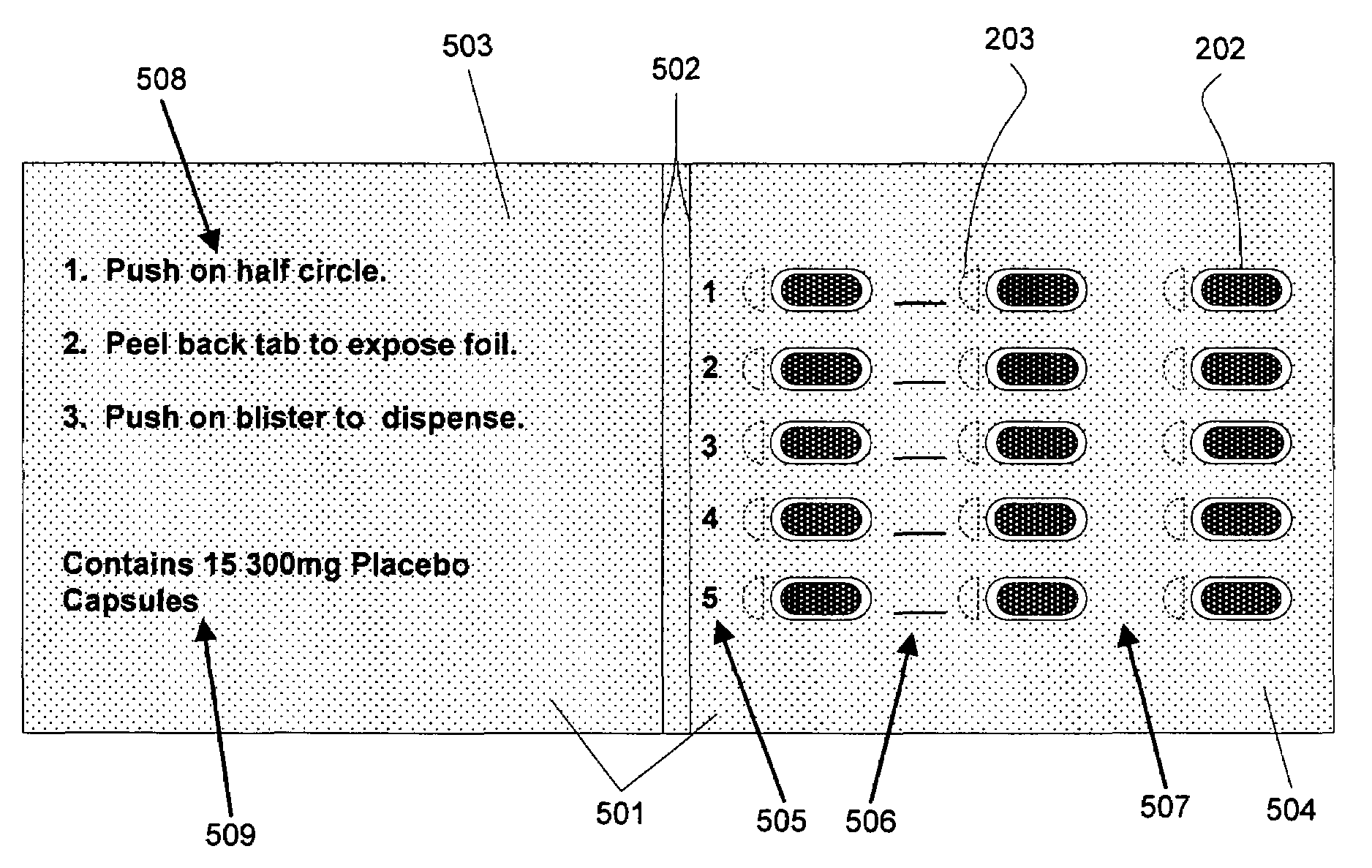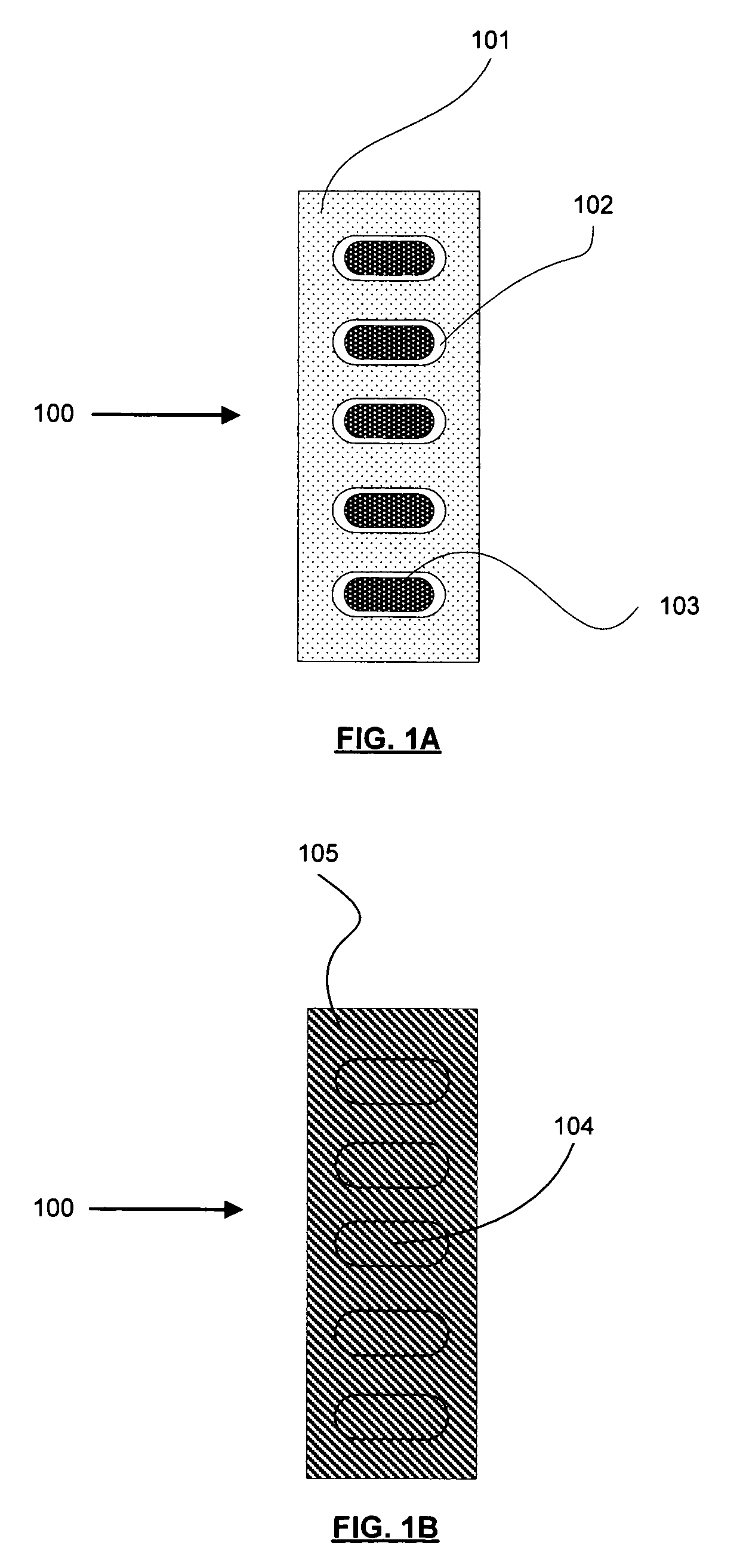After the aforementioned modifications were made, many blister card packages that were previously non-child-resistant were able to pass child resistance testing; however, the packaging became undesirable in several other ways.
For example, the additional reinforced layers often prevented the product from being pushed cleanly through the blister backing.
This can be very difficult, especially for senior citizens or other adults with impaired physical abilities.
Furthermore, once the backing is grasped and torn, a user can easily tear too much backing.
This excessive tearing is undesirable, especially when blister strips or solid-form blisters are used.
The tearing may run into an adjacent blister, allowing another product or item to be prematurely dispensed.
Additionally, the user may not be able to scrape enough backing to the point where the backing may be pulled away, causing the user to utilize a sharp object such as a knife or scissors.
Cutting of the blister card packaging can lead to many more problems, including unintentional damage to the product, damage to the printed instructions on the packaging, or injury to the person.
This leads to at least two major problems.
First, the content of the blister may be damaged and unusable.
Second, the user may resort to bending the overall blister card package causing damage to the blister, the blister card, or the content of the blisters.
Conventional blister card packages also exhibit many other undesirable qualities.
These blister card packages are prone to theft and product tampering because the paperboard backing can easily be torn and the item contained therein can be effortlessly removed increasing opportunities for theft and tampering of the item.
These heavy gauge plastic blisters are extremely inconvenient because they usually require tools, such as knives or scissors, and a large amount of physical strength to open the blister and access the product.
In addition, these heavy gauge plastic blisters cannot be directly printed on, which makes them less attractive and offers less marketing potential for vendors.
However, such tear-proof paperboard often exhibits small nicks or cuts in the edge of the paperboard due to manufacturing, transport, and handling.
While such tear-proof paperboard technology can improve the theft resistance of blister card packages, they are still prone to theft and product tampering.
In addition, the effectiveness of the tear resistance is diminished because a small tear or nick in the edge of a sheet can lead to the total failure of the tear-resistant material due to the propagation of the tear.
Many problems exist with peel-push blister card packaging.
One such problem is the difficulty involved with grasping the outer layer so that it may be peeled.
Since many outer layers are difficult to grasp, users tend to bend the overall packaging or use sharp objects to remove the outer layer.
This results in damage to the packaging or to the products themselves.
In particular, some of these outer layers are so difficult to grasp that senior citizens or other adults suffering from diminished physical abilities or poor eyesight may not be able to access the blister product without assistance.
Also, the damage to the packaging reduces or frequently eliminates its child resistance.
Another problem with peel-push packaging is evident in blister packages containing multiple products or applications.
In these packages, even if the user is able to grasp the outer layer, the user often removes too much of the outer layer, thereby accessing adjacent products.
Furthermore, the blister card packaging does not have any means of reducing theft or product tampering.
The blister card packaging disclosed in Davie suffers the same limitations as other peel-push packaging.
Namely, the outer layer is difficult to grasp prior to peeling.
In addition, the Davie product is actually designed to expose the frangible layer of products that are not ready to be removed.
This aspect obviously diminishes the child resistant capabilities of the unopened package.
Although Dlugosz discloses a better method of grasping the tear strip, Dlugosz still requires the bending of the packaging.
Also, Dlugosz does not disclose a method that prevents the user from tearing more of the backing than necessary to expose the frangible layer of the desired product.
Finally, the tear strip may still be difficult to grasp for senior citizens or other adults suffering from diminished physical abilities.
Furthermore, Dlugosz does not disclose any means for reducing theft or product tampering.
Although the Intini '004 patent discloses a better method of grasping the outer non-frangible layer, the Intini '004 patent still requires the user to bend the packaging.
This may be difficult for frail adults, especially those suffering from an ailment such as arthritis.
Furthermore, because the Intini '004 patent requires both foil and paper frangible layers, it is difficult to push the product through the two frangible layers.
Furthermore, seniors have a more difficult time pressing products through the thicker frangible layers.
Although the additional layer containing the T-shaped perforation may provide a higher child resistance rating, the additional layer adds another level of complexity for those users who suffer from diminished physical abilities or poor eyesight.
Also, Bitner does not disclose any theft resistance means for the blister card package.
Similar to the packaging disclosed in Bitner, although the additional complexity required to access the content of the blister might achieve a higher child resistance rating, the additional complexity also makes the content of the blister less accessible to those users who suffer from diminished physical abilities or poor eyesight.
Also, the Sowden product does not have any means to deter theft or product tampering.
The packaging disclosed in Matthews suffers from the same limitations as the aforementioned packaging containing two distinct layers.
Namely, there is an additional level of complexity required to access the product, and the possibility exists for the user to tear more of the backing than required.
As a result, the child resistant properties of the packaging of the remaining products are reduced.
However, these limitations are magnified by the addition of a third layer, i.e., the outermost non-frangible layer.
Furthermore, the blister card packaging does not have any means of reducing theft or product tampering.
Again, the Vasquez packaging requires multiple, intricate steps that will be difficult to perform by users suffering from diminished physical abilities or poor eyesight.
Also, the Vasquez product does not have any means to deter theft or product tampering.
Furthermore, Leblong does not disclose any means for reducing theft or product tampering.
However, none of these patents disclose a method that prevents the user from removing more of the backing than that which covers the intended blister or blisters to be dispensed.
In addition, although the pull-tab facilitates removal of the blister backing for an adult, the pull-tab also reduces the package's child resistance by facilitating removal of the blister backing by a child.
Again, the product does not have any theft resistance qualities.
In contrast, if the rigidity of the perforated ovals is high, the Godfrey packaging impedes access to the content of the blister for adults having impaired physical abilities.
Also, Godfrey does not disclose any theft resistance means for the blister card package.
These three steps can be very difficult for a senior citizen or other adult with impaired physical abilities.
Such individuals may resort to sharp objects for removal of any of the aforementioned layers, which is likely to damage the packaging or product contained within the packaging.
Also, the Gartland product does not have any means to deter theft or product tampering.
Whereas the lack of adhesion between the outer and inner layers of the backing facilitates removal of the backing, the multiple peels required to remove the blister's content renders the Danville packaging difficult for adults having impaired physical abilities.
Furthermore, the blister card packaging does not have any means of reducing theft or product tampering.
The blister card packaging disclosed in Swartz does not contain a method of preventing more than the desired backing from being torn.
Additionally, the pressure exerted on the packaging to form the pull-tab may damage the packaging.
Also, the Swartz product does not have any means to deter theft or product tampering.
 Login to View More
Login to View More 


